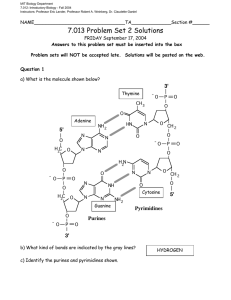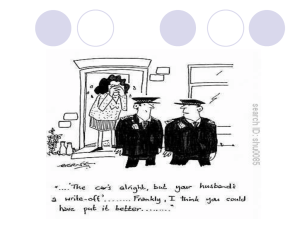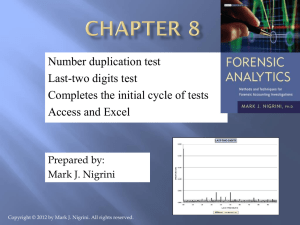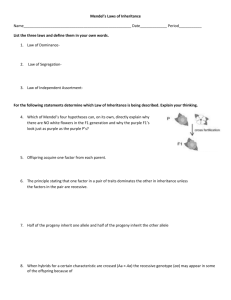Document 13478088
advertisement
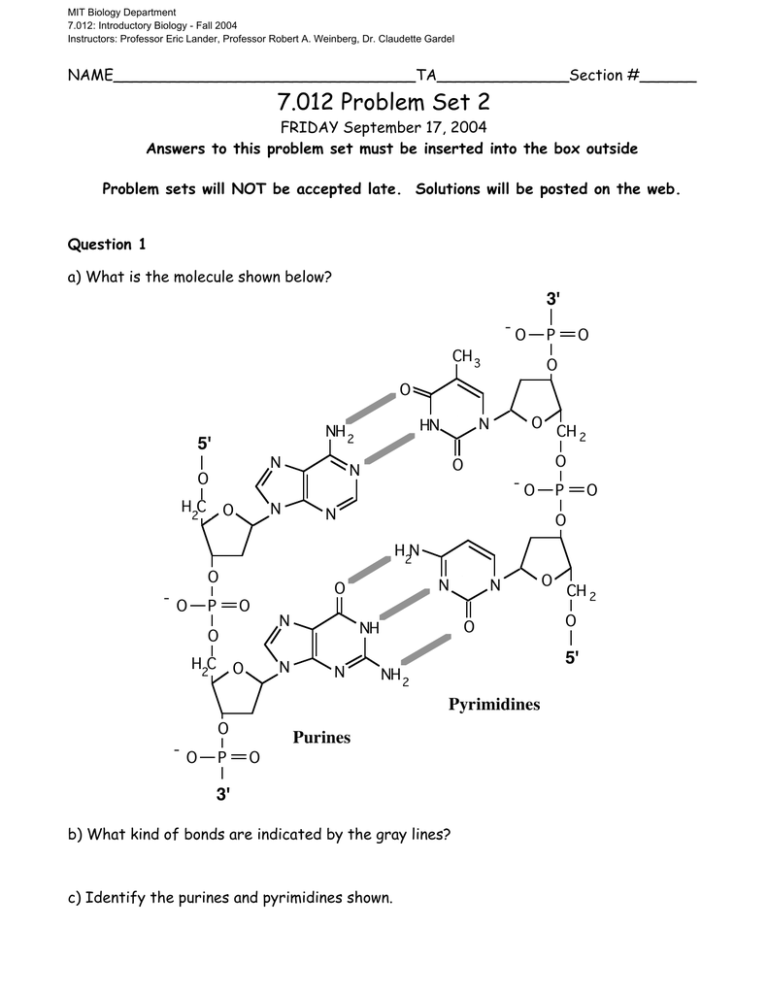
MIT Biology Department 7.012: Introductory Biology - Fall 2004 Instructors: Professor Eric Lander, Professor Robert A. Weinberg, Dr. Claudette Gardel NAME________________________________TA______________Section #______ 7.012 Problem Set 2 FRIDAY September 17, 2004 Answers to this problem set must be inserted into the box outside Problem sets will NOT be accepted late. Solutions will be posted on the web. Question 1 a) What is the molecule shown below? 3' - O P CH 3 O O O HN NH 2 5' N O A HC N O 2 T O N O O N CH 2 - O P N O O HN 2 O - P O O O HC N G N O 2 N O N C N O NH - O P Purines O 3' b) What kind of bonds are indicated by the gray lines? c) Identify the purines and pyrimidines shown. CH 2 O 5' NH 2 Pyrimidines O O Question 2 Harry studies plum tree genetics. He had a pure-breeding mutant strain of plum trees that has two unusual characteristics; the mutant tree produces figs instead of plums and there are huge spikes growing out of the branches. Harry crossed the mutant with a pure-breeding wild-type plum tree. The F1 progeny produce figs, but have no spikes. F0: Mutant fig tree with spikes X Wild type plum tree fig trees F1: a) For each pair, circle the dominant phenotype. Plums Figs Spikes No spikes b) Harry performed a backcross of an F1 individual with an F0 individual from the mutant strain. If there are 32 progeny trees from this cross how many trees have each of the following phenotypes? Figs, spikes __________ Figs, no spikes _________ Plums, spikes __________ Plums, no spikes __________ Harry performed a test cross of an F1 individual (from the very first cross) with a tree exhibiting both of the phenotypes that you have identified as recessive. He got progeny with the following characteristics. Phenotype # of individuals in F2 generation Figs, spikes 897 Figs, no spikes 97 Plums, no spikes 903 Plums, spikes 103 c) What is the recombination frequency between the “fig” and the “spike” genes? Show your work. _____________ Harry had previously identified a mutant plum tree whose branches are magical, and can be used to make magic wands. The gene that produces this phenotype (the “wand” gene) was previously determined to be 6 map units away from the “spike” gene on one chromosome. d) Based on the above data, there are two possible arrangements for the “fig”, “spike”, and “wand” genes on the chromosome. Draw them below naming the genes in the boxes and indicating between them the distances in map units. Arrangement 1: Arrangement 2: e) What experiment could Harry perform to distinguish between these two possibilities? 3 Question 3 The following diagrams show a diploid cell with 2 chromosomes, 1 and 2. The chromosome derived from the mother is denoted "m", and the chromosome derived from the father is denoted "d". a) The picture below shows the end of mitosis/meiosis I/meosis II. (Circle one.) 1m 1m A1 2d 1d 2m 2d 1d 2m b) The picture below shows the end of mitosis/meiosis I/meosis II. (Circle one.) 1m 1m 1m 2d 2d 2d 1d 1d 1d 2m 2m 2m c) The picture below shows the end of mitosis/meiosis I/meosis II. (Circle one.) 1m 1d 1m 1d 1m 1d 2m 2d 2m 2d 2m 2d d) In which stage of mitosis or meiosis does most of the recombination occur? Explain why. Question 4 It is Year 2030, and the first “personned” expedition to Mars is successful. (With the invention of impulse engines and inertial dampers, this is a trivial accomplishment.) A stunning discovery is made: There is life on Mars! There are round, purring fuzzy, friendly, furry creatures that come in 3 colors: Plush Purple, Ruby Red and Bright Blue. They are dubbed “Martianiti tribbli”, “tribbles” for short (an allusion to an archaic 20th Century television show). The MIT rocket scientists come to you, a renowned geneticist, Prof. Seven O. Tu to solve the mystery of tribble coat inheritance. Here are the facts. The scientists can get pure breeding lines of Blue and Red tribbles, but cannot get pure breeding Purple tribbles. Cross 1: Blue x Red F1: All Purple tribbles a) What is the inheritance pattern for coat color? (Circle one) Complementation Dominant Recessive Codominant X-Linked b) What is the predicted ratio of Blue: Red: Purple tribbles for each of the following crosses? i) Cross: Red x Purple F1: Blues:______________ Reds:______________ Purples: ______________ ii) Cross: Purple x Purple F1: Blues:______________ Reds:_____________ Purples: ______________ iii) Cross: Blue x Blue F1: Blues:______________ Reds:_____________ Purples: ______________ 5 Question 4 continued You find that there is another gene locus (Albino) that controls coat color and is epistatic to the red/purple/blue color locus. When (and only when) a tribble is homozygous “aa” for this locus, it is pure white, “albino”. (Assume that allele B codes for Blue color and allele b codes for Red color.) c) Predict the coat color for tribbles with the following genotype: i) Genotype: BB aa ; Phenotype: __________________ ii) Genotype: BB AA ; Phenotype: __________________ iii) Genotype: Bb Aa ; Phenotype: __________________ iv) Genotype: bb aa ; Phenotype: __________________ d) Fill in the ratio of progeny classes from the following crosses. Cross Purple Progeny Blue Progeny Red Progeny White Progeny BBAA X Bbaa 1 1 0 0 BbAa X BbAa Bbaa x BBaa Bbaa X bbAa Question 5 A woman with blood type O has a child with blood type O. She claims that a friend of hers is the child's father. In the ABO system, IA and IB are both dominant to i and are codominant to each other. ABO genotypes are summarized below and described on page 211 of the 1th edition of Freeman. IAIA and IAi IBIB and IBi IAIB i A B AB O a) Her friend’s blood type is A. Can he be excluded as the father on this evidence alone? b) Does the fact that the accused man's mother has type A and his father has type AB exclude him from being the parent? c) Does the additional information that his mother's parents are both AB permit him to be excluded? 7
